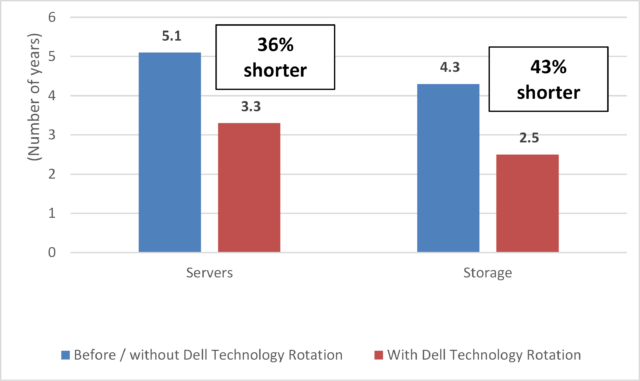As AI adoption accelerates in all types and sizes of organizations worldwide, IT infrastructure choices matter more than ever. The pace of change alone is driving increased interest in subscription-based solutions for servers and storage to maintain “state-of-the-art” capabilities via earlier and regular technology refreshes. Are subscription-based solutions right for your organization?
Beyond AI, a recent study by IDC and commissioned by Dell Technologies compares and financially quantifies the benefits of Dell Technology Rotation, a subscription-based solution, versus buy-and-hold solutions for servers and storage. Dell Technology Rotation is a payment solution to acquire, use and then return technology after the initial term, which can range from 12-60 months.
The IDC study surveyed and interviewed customers to get a real-world perspective. Findings from the study can help organizations optimize their budgets and support better business outcomes–today and in the future.
IDC calculates that, over six years, organizations realize operational cost savings with two three-year Dell Technology Rotation subscription cycles compared with one six-year cycle of buying and holding equivalent infrastructure. Per IDC projections, on average, organizations using Dell Technology Rotation will save 22% on server cost of operations and 40% on storage cost of operations. The IDC study also revealed that refreshing technology on fixed intervals also makes IT support teams more efficient by reducing challenges related to aging infrastructure.
Gaining four major benefits
Organizations in the IDC study outlined the most significant benefits of deploying a subscription-based approach for server and storage resources with Dell Technology Rotation. The four major organizational advantages realized—as explained in customers’ words–are:
-
- Free up Capex dollars for other projects
“The main reason we use Dell Technology Rotation, whether for servers or storage, is that it frees up Capex dollars for other projects where those funds can be better utilized, rather than being tied up in operational solutions.”
-
- Enable ready scalability to fuel faster growth
“Dell Technology Rotation enhances our agility and scalability, allowing us to grow faster wherever needed. It makes scaling much easier.”
-
- Decrease downtime with access to newer technology
“Having access to newer technology with Dell Technology Rotation has significantly decreased downtime. It has made it easier for us to adopt innovations like large language models that require the latest processors.”
-
- Refocus on innovation
“Dell Technology Rotation has helped us scale to new customers, allowing for easy expansion and adaptation to our business needs. It has also provided cost savings and reduced time spent on repetitive tasks. Overall, the program has enabled us to focus on innovation.”
Realizing subscription-based savings
Dell Technology Rotation customers avoid upfront capital expenditures (Capex), allowing them to better leverage financial resources for other IT and business priorities. Instead, Dell Technology Rotation spreads infrastructure costs over time in an operating expenditure (Opex) model, which also incorporates warranty and support arrangements, reducing staff time spent on managing agreements.
Further, IDC calculated several areas of potential cost savings via Dell Technology Rotation. Study participants reported average refresh cycles 36% faster for servers and 43% faster for storage.

Refresh cycles are the basis for other cost savings potential. That’s because aging infrastructure can erode efficiencies, incur more downtime, and require more staff time.
Efficiency: IDC calculates an average gain in efficiency of 37% for both server and storage resources through Dell Technology Rotation.
Downtime: Aging server and storage resources also experience more unplanned and costly outages. Dell Technology Rotation customers report fewer outages and faster outage resolution, creating 62% less unplanned downtime for servers and 78% for storage.
Staff time: Study participants estimated staff time on management activities to increase from 1-3 years of the lifecycle versus 4-6 years. Servers required 48% more staff time, and storage 49% more.
Choosing Your IT Infrastructure Path
As AI moves more mainstream and technology becomes even more crucial, subscription-based solutions like Dell Technology Rotation are answering multiple needs. Per the IDC study, the subscription experience results in lower cost of operations, more efficient technology, and less unplanned downtime. In addition, refreshing technology on fixed intervals delivers more efficiency, less downtime, and reduced staff time managing IT compared to aging infrastructure.
“Per the IDC study, the subscription experience results in lower cost of operations, more efficient technology, and less unplanned downtime.”
Using the IDC study on Dell Technology Rotation as a guide will help you answer the important question: When it comes to IT infrastructure, should you buy or subscribe? Please reach out to discuss your specific organizational needs to find the right answer for your business.
Read the full IDC report.
Learn more about Dell Technology Rotation.
* IDC Business Value In-depth Interviews, August 2024


